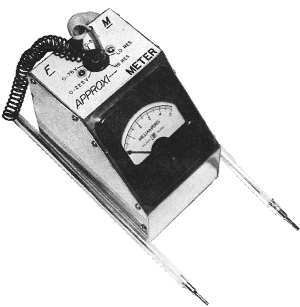|
Here is an example of
just how far we have come in the realm of electronics. In a world where you can
go to Harbor Freight and buy a digital multimeter with an accuracy of 1% or better
for a mere $3, this article from the July 1958 edition of Flying Models
illustrates the dedication that was necessary in order to outfit yourself with even
the most fundamental tools for flying radio control airplanes. It was part of an era
where building your own electronic device was less expensive than buying one prefabricated.
Such was the case for the aircraft radios, too, as evidenced by the number of advertisements
in magazines of the day for kits.
As is often true, there are good and bad aspects of building versus buying. Building
gives you the intricate knowledge of how everything goes together and functions
along with actually using the stuff you build. However, the ability to buy your
equipment pre-built leaves more time for honing flying skills. That last statement
helps explain the incredible level of competency exhibited by the young 3-D airplane
and helicopter flyers.
Approxi-Meter -There's no need to buy an expensive meter for R/C flying
by Ted Strader
 The barest necessities in R/C usually include
a milliammeters in the 0-1, 0-3 or 0-5 mA range to tune the majority of receivers
to frequency. The barest necessities in R/C usually include
a milliammeters in the 0-1, 0-3 or 0-5 mA range to tune the majority of receivers
to frequency.
With the basic parts acquired, the R/Cer's next desire is some form of indicator
to at least check batteries.
The Approxi-Meter is designed to turn your basic milliammeters into a simple
volt-ohm-milliammeters (VOM) using parts you may find in your junk box, and if
not, components which can be bought for less than a buck! To keep cost down a tube socket
was used instead of a selector switch for circuit transfers.
When finished you will be able to check three voltage ranges with reliable accuracy;
use the low resistance section to check continuity of receiver and battery leads,
relay points and general low impedance wiring (0 to 2K ohms); use the high resistance
section to check coil windings, resistor continuity, shorted condensers and general
resistances from 2K to infinity.
Diodes can also be checked but in reverse, i.e., contact the cathode end
(bar) to the negative prod and other end to positive prod. If diode is good,
little or no movement will result in the high resistance range. (A commercial
VOM is so wired, through its selector switch as to maintain polarity for this operation).
The sketch will clarify most points - a few notes may 0-3 and 0-5 milliammeters
use the same value resistors; 0-1 mA meters use the resistor values in parentheses
and have the same full scale readings as the 0-5 meters.
All connections are made between tube socket lugs and meter post lugs. The lead
from positive meter lug passes through the tube socket center lug and may be soldered
to it for more support.
 The batteries in the resistance check circuit
will last as long in the Approxi-Meter as on the shelf if not shorted, and do
not necessarily have to be absolutely fresh. The selector pin end of the
negative prod is a small wire brad soldered to the wire and covered with a short
length of neoprene tubing. Prod ends are phone tips, heated and forced into
short lengths of poly tubing after connections are made. These can be altered to suit available material. The batteries in the resistance check circuit
will last as long in the Approxi-Meter as on the shelf if not shorted, and do
not necessarily have to be absolutely fresh. The selector pin end of the
negative prod is a small wire brad soldered to the wire and covered with a short
length of neoprene tubing. Prod ends are phone tips, heated and forced into
short lengths of poly tubing after connections are made. These can be altered to suit available material.
The case was fashioned from thin sheet aluminum. A cookie sheet will supply a
good grade of sheet or you may have a small box into which the parts will fit.
One last note: In case you'd like to invest about 50¢ more you can get 5% tolerance
resistors and make the 0-1 milliammeters more accurate by employing resistors with
values closer to what they actually should be. Substitute 5.1K for 4.7K, 75K for
82K and 0.24M for 0.27M.
Users of 0-3 and 0-5 milliammeters can get more accuracy. from the high voltage
range by substituting a 51K for the 47K.
We used 10% tolerance resistors only because the idea was to keep the cost down
as low as possible.
Though hand-built this meter has all of the appearance of a professionally made
unit. A single 0-5 milliammeters is all you need to make this combination Volt-Ohm-Ammeter
for R/C tests.
Posted March 23, 2022
(updated from original post on 11/19/2010)
|